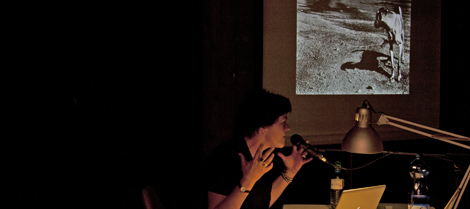| « If We Can't Save the Planet, There's Still Space ... Or Not? | Another Sneak Peak » |
"A Lot of Things Happened Per Chance"
In the last lunch talk of this year, we had the pleasure to learn more about a fascinating photographer from South Africa, Jo Ractliffe.
She briefly explains how she got into working with what she calls "plastic toy cameras" because all of her other photo equipment had been stolen, using a lomo camera named Diana through the 90s until she came across an exhibition that said something like "take great, artsy, blurry pictures" and decided it was enough, returning to proper equipment.
No matter what she uses to take pictures though, she's always interested in reality. She doesn't go and constructs something with her camera, sh
e does precisely the opposite, like we could see in a series of pictures she took on one of her trips to neighbouring Angola after the civil war ended there in 2002. First one only sees a black-and-white landscape, something friends have lovingly called "blandscape", but then you start noticing funny little signs and the peace of the image is disturbed, going completely out of the window as the artists starts telling us that the images show minefields and the little signs on poles mark safe paths although one can never be sure as frequent floods shift the land mines around underground.
Jo always has a sharp eye for the reality, something that might come from growing up in the Apartheid government. As she says herself, "during the turbulent times in the 80s and 90s, every photographer automatically became a documenter of what was happening." She still works along those lines, but more subtle, with messages that still need discovering, which in my opinion is brilliant in a time when photos are first-of-all hugely blown up, using sophisticated technology and intricate photoshop processes and only then bumbles along the meaning,
We'll see this Friday how much of this way of working rubbed off on her students, at our open day, running from 2 to 6 pm. [mp]



